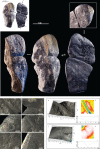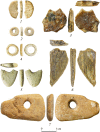Symbolic innovation at the onset of the Upper Paleolithic in Eurasia shown by the personal ornaments from Tolbor-21 (Mongolia)
- PMID: 37308668
- PMCID: PMC10261033
- DOI: 10.1038/s41598-023-36140-1
Symbolic innovation at the onset of the Upper Paleolithic in Eurasia shown by the personal ornaments from Tolbor-21 (Mongolia)
Abstract
Figurative depictions in art first occur ca. 50,000 years ago in Europe, Africa, and Southeast Asia. Considered by most as an advanced form of symbolic behavior, they are restricted to our species. Here, we report a piece of ornament interpreted as a phallus-like representation. It was found in a 42,000 ca.-year-old Upper Paleolithic archaeological layer at the open-air archaeological site of Tolbor-21, in Mongolia. Mineralogical, microscopic, and rugosimetric analyses points toward the allochthonous origin of the pendant and a complex functional history. Three-dimensional phallic pendants are unknown in the Paleolithic record, and this discovery predates the earliest known sexed anthropomorphic representation. It attests that hunter-gatherer communities used sex anatomical attributes as symbols at a very early stage of their dispersal in the region. The pendant was produced during a period that overlaps with age estimates for early introgression events between Homo sapiens and Denisovans, and in a region where such encounters are plausible.
© 2023. The Author(s).
Conflict of interest statement
The authors declare no competing interests.
Figures





Similar articles
-
Initial Upper Paleolithic bone technology and personal ornaments at Bacho Kiro Cave (Bulgaria).J Hum Evol. 2022 Jun;167:103198. doi: 10.1016/j.jhevol.2022.103198. Epub 2022 May 6. J Hum Evol. 2022. PMID: 35533625
-
Zhoukoudian Upper Cave personal ornaments and ochre: Rediscovery and reevaluation.J Hum Evol. 2021 Dec;161:103088. doi: 10.1016/j.jhevol.2021.103088. Epub 2021 Nov 24. J Hum Evol. 2021. PMID: 34837740
-
The three waves: Rethinking the structure of the first Upper Paleolithic in Western Eurasia.PLoS One. 2023 May 3;18(5):e0277444. doi: 10.1371/journal.pone.0277444. eCollection 2023. PLoS One. 2023. PMID: 37134082 Free PMC article.
-
The success of failed Homo sapiens dispersals out of Africa and into Asia.Nat Ecol Evol. 2018 Feb;2(2):212-219. doi: 10.1038/s41559-017-0436-8. Epub 2018 Jan 18. Nat Ecol Evol. 2018. PMID: 29348642 Review.
-
Denisovans and Homo sapiens on the Tibetan Plateau: dispersals and adaptations.Trends Ecol Evol. 2022 Mar;37(3):257-267. doi: 10.1016/j.tree.2021.11.004. Epub 2021 Dec 1. Trends Ecol Evol. 2022. PMID: 34863581 Free PMC article. Review.
Cited by
-
Multivariate analyses of Aurignacian and Gravettian personal ornaments support cultural continuity in the Early Upper Palaeolithic.PLoS One. 2025 Jun 4;20(6):e0323148. doi: 10.1371/journal.pone.0323148. eCollection 2025. PLoS One. 2025. PMID: 40465694 Free PMC article.
-
Use of hare bone for the manufacture of a Clovis bead.Sci Rep. 2024 Feb 5;14(1):2937. doi: 10.1038/s41598-024-53390-9. Sci Rep. 2024. PMID: 38316967 Free PMC article.
-
Ethnographic toolstone heat treatment reveals distinctive motives and patterns of material transformation.Sci Rep. 2025 Apr 14;15(1):12854. doi: 10.1038/s41598-025-97207-9. Sci Rep. 2025. PMID: 40229341 Free PMC article.
References
-
- Klein RG. Anatomy, behavior, and modern human origins. J. World Prehist. 1995;9:167–198. doi: 10.1007/BF02221838. - DOI

